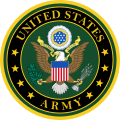Battle of Okinawa
During the Battle of Okinawa (1 April through 22 June 1945), the Tenth Army consisted of XXIV Corps of the U.S. Army (consisting of the 7th, 27th, 77th and 96th Army infantry divisions) and III Amphibious Corps of the U.S. Marine Corps (consisting of the 1st, 2nd and 6th Marine divisions). The Tenth Army was unique among field armies in that it had its own Tactical Air Force, Tenth Army, a joint Army-Marine formation. [1]
The Army had over 102,000 soldiers (of these 38,000+ were non-divisional artillery, combat support and HQ troops, with another 9,000 service troops), [1] over 88,000 Marines and 18,000 Navy personnel (mostly Seabee and medical personnel). [1] At the start of Battle of Okinawa, Tenth Army had 182,821 men under its command. [1]
In all, Tenth Army suffered 65,631 casualties during the campaign, with 34,736 being suffered by XXIV Corps, 26,724 by III Amphibious Corps, 520 to the tactical air force attached to Tenth Army, 2,636 to the Army garrison forces of Okinawa and Ie Shima, and 1,015 to troops directly under the command of Tenth Army. As noted earlier, one of those casualties was the commander of the Tenth Army himself, killed by an enemy shell burst while visiting a forward position. The day after, a second general, Brigadier General Claudius M. Easley, was killed by machine gun fire. [4] General Joseph Stilwell was selected to succeed General Buckner as commander of the Tenth Army.
Okinawa turned out to be the only campaign that Tenth Army would take part in during World War II. It was earmarked to take part in Operation Coronet, the second phase of the invasion of Japan, but the dropping of the atomic bombs on Hiroshima and Nagasaki, and subsequent Japanese surrender, obviated the need to invade Japan. The Tenth Army was disbanded on 15 October 1945.


